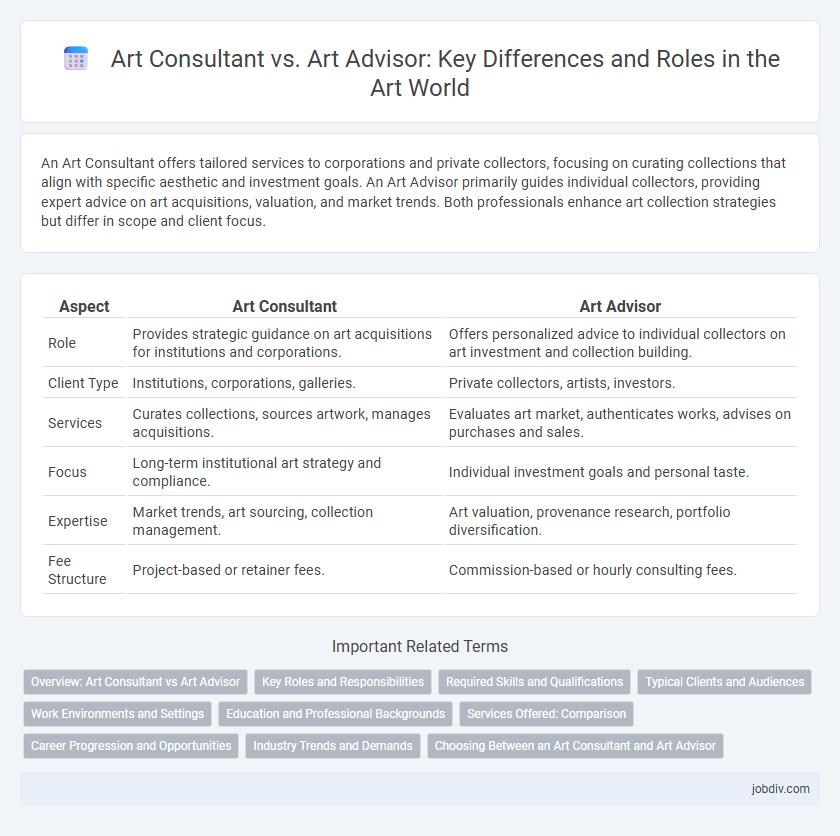An Art Consultant offers tailored services to corporations and private collectors, focusing on curating collections that align with specific aesthetic and investment goals. An Art Advisor primarily guides individual collectors, providing expert advice on art acquisitions, valuation, and market trends. Both professionals enhance art collection strategies but differ in scope and client focus.
Table of Comparison
| Aspect | Art Consultant | Art Advisor |
|---|---|---|
| Role | Provides strategic guidance on art acquisitions for institutions and corporations. | Offers personalized advice to individual collectors on art investment and collection building. |
| Client Type | Institutions, corporations, galleries. | Private collectors, artists, investors. |
| Services | Curates collections, sources artwork, manages acquisitions. | Evaluates art market, authenticates works, advises on purchases and sales. |
| Focus | Long-term institutional art strategy and compliance. | Individual investment goals and personal taste. |
| Expertise | Market trends, art sourcing, collection management. | Art valuation, provenance research, portfolio diversification. |
| Fee Structure | Project-based or retainer fees. | Commission-based or hourly consulting fees. |
Overview: Art Consultant vs Art Advisor
Art consultants specialize in curating and managing art collections for corporate clients and interior designers, focusing on acquisition strategies and aesthetic coherence. Art advisors guide individual collectors through art investments, provenance research, and market trends to maximize portfolio value. Both roles require deep market knowledge but differ in client focus and scope of services.
Key Roles and Responsibilities
Art consultants primarily focus on guiding collectors and institutions in acquiring artworks that align with their aesthetic preferences and investment goals, leveraging market trends and artist reputations to optimize portfolio value. Art advisors provide personalized advice on art selection, provenance verification, and collection management while emphasizing legal and ethical considerations to ensure authenticity and compliance. Both roles require deep knowledge of the art market, but consultants often engage in broader strategic planning, whereas advisors concentrate on individualized client relationships and collection curation.
Required Skills and Qualifications
Art consultants must possess strong project management skills, an in-depth knowledge of contemporary and historical art trends, and excellent client relationship abilities to guide acquisitions that align with aesthetic and financial goals. Art advisors require a deep understanding of art valuation, market dynamics, and legal knowledge in art transactions, along with expertise in portfolio diversification and investment strategies. Both roles demand formal education in art history or fine arts, supplemented by experience in galleries or auction houses, but art advisors often need additional credentials in finance or law to navigate complex market regulations effectively.
Typical Clients and Audiences
Art consultants typically serve corporate clients, interior designers, and large-scale collectors seeking curated collections and strategic acquisitions to complement specific spaces or brand identities. Art advisors often work with individual collectors and investors focusing on personalized art portfolios, market trends, and art valuation for private ownership. Both professionals tailor their services to different client needs, with consultants addressing broader institutional goals and advisors providing bespoke guidance for personal collections.
Work Environments and Settings
Art consultants typically operate within galleries, auction houses, or corporate environments, providing expertise on art acquisitions and collections tailored to client needs. In contrast, art advisors often work independently or with private collectors, offering personalized guidance for purchasing and managing art assets. The work environment for consultants tends to be more structured and commercial, while advisors engage in more flexible, client-centric settings.
Education and Professional Backgrounds
Art consultants typically hold degrees in fine arts, art history, or business, combining creative knowledge with market expertise to guide clients in acquisitions and collections management. Art advisors often possess advanced studies in art curation, conservation, or cultural heritage, emphasizing scholarly research and personalized advising for high-net-worth collectors and institutions. Both roles demand extensive professional experience in galleries, auction houses, or museums, but art consultants lean more towards commercial strategy while art advisors focus on intellectual and aesthetic valuation.
Services Offered: Comparison
Art consultants offer comprehensive services including collection development, market analysis, and vendor negotiation, specializing in tailored acquisition strategies for private and corporate clients. Art advisors primarily provide expert guidance on artwork selection, investment potential, and portfolio diversification, focusing on enhancing the client's aesthetic and financial goals. While consultants often manage logistical aspects and project coordination, advisors concentrate on personalized art market insights and valuation advice.
Career Progression and Opportunities
Art consultants typically focus on sourcing and managing art collections for corporate or private clients, leveraging market trends to enhance portfolio value, which opens pathways to gallery management or curatorship. Art advisors provide specialized guidance on art investment and acquisition strategies, often collaborating with collectors and museums, leading to opportunities in art investment firms or cultural institutions. Both roles demand a deep understanding of art history and market dynamics, with career advancement hinging on building extensive networks and industry credibility.
Industry Trends and Demands
Art consultants focus on curating collections aligned with client aesthetics and market value, leveraging expertise in contemporary art trends and auction results. Art advisors emphasize personalized investment strategies, guiding clients through emerging artists and global art fairs to optimize portfolio diversification. Both roles respond to rising demands for art as alternative assets amid evolving industry dynamics and digital market platforms.
Choosing Between an Art Consultant and Art Advisor
Choosing between an art consultant and an art advisor depends on your specific needs and goals within the art world. Art consultants typically offer comprehensive services including art selection, installation, and collection management for corporate or private clients, while art advisors primarily focus on guiding collectors through acquisitions and investment strategies. Understanding the distinct expertise and roles of each professional ensures informed decisions that enhance your art collection and align with your financial and aesthetic objectives.
Art Consultant vs Art Advisor Infographic

 jobdiv.com
jobdiv.com